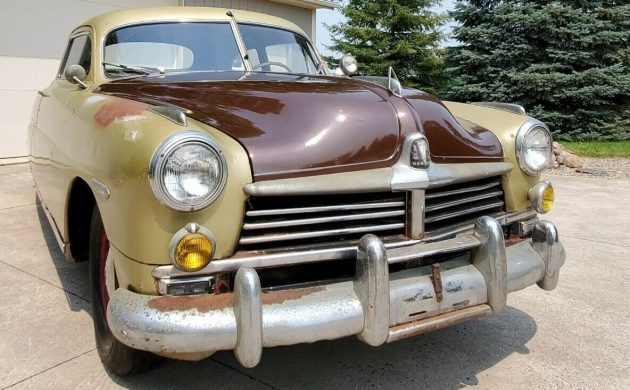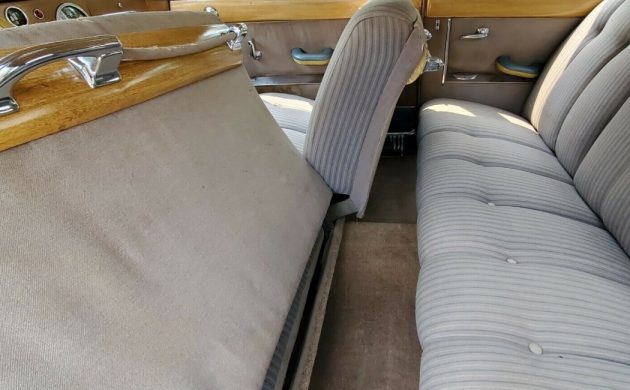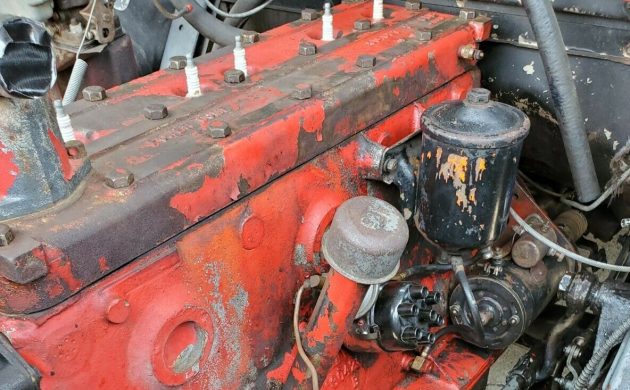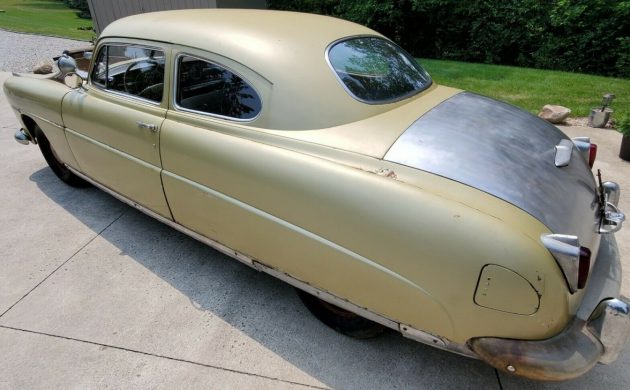It’s hard not to wonder at the fate of Hudson Motors, an innovative company that seemed to have so much going for it during the postwar years. Here we have an example of that innovation, produced only eight years before the brand disappeared for good: a 1949 Hudson Commodore 8. This beautiful coupe currently calls Antwerp, Ohio, home, and is up for auction here on eBay. The bid currently sits at $2,500 with seven days left to go, but if you can’t wait, there’s the option to take it home today for $15,000.
While the brand is enjoying a resurgence of interest due to a certain animated film, a few of us might have been introduced to Hudsons through Jack Kerouac’s On the Road. A 1949 Hudson, much like this one, features prominently in the story. It was a fitting choice for a book about jazz and speed and the hunt for America because, as Dean Moriarty said, “that Hudson goes!” The revolutionary step-down design significantly lowered the center of gravity while the 262 cubic inch inline-six produced 128 horsepower from the factory– significantly outclassing the Shoebox Ford’s V8, just to name one example. Although this car would have come from the factory with an inline-eight, it’s now equipped with the six: hardly a downgrade when one considers that there’s little difference in horsepower between the two and the 262 beats the original engine for torque.
But the engine, body, and chassis are not the only technical innovations pioneered at Hudson at the close of the Forties. It was during this time, for a few brief years before they adopted GM’s Hydramatic, that Hudson boasted one of the most remarkable transmissions to ever appear as an option: the Drive-Master. In 1949 you could buy a Hudson with a standard three-on-the-tree manual, or the semi-automatic Vacumotive Drive, which allowed for shifting without depressing the clutch pedal. Or you could go for the Drive-Master, which incorporated both of these options, as well as giving a third. Drivers would select among these using a knob on the dash, just to the left of the lights switch. Center was manual, turning left engaged Vacumotive, but turning the knob right enabled the driver to take off in second and shift to third by letting up off the accelerator, no shift lever manipulation required. The transmission would automatically drop back into second when the car dropped below “shifting speed,” as long as the driver’s foot was off the gas. If desired, one could always downshift manually, even in Drive-Master mode.
Given this range of transmission options, it’s understandable that the seller might be reluctant to talk about this feature in the listing. Fortunately, fairly comprehensive literature on both Vacumotive and Drive-Master is available through an internet search. While neither of these options proved to be a viable alternative to the automatic transmission at the time, the idea of carmakers allowing you to choose how you shift gears would eventually make a comeback in today’s paddle-shift automatics. The car here appears to be a fine candidate for restoration and an example of a model rarely seen with two doors, but it’s so much more: a testament to mid-century American engineering prowess, a rolling witness to the birth of America’s tradition of youth rebellion, and, in some ways, the swan song of an automaker gone too soon.





Thanks Andy for the engineering-focused review. I learned some things.
Speaking of engineering, I’m pretty impressed with the engineering of this era, for example the machines used as part of WW2. And to think that these were designed and engineered using high-tech equipment such as compasses, protractors, columnar paper…. not a hand calculator in sight let alone a computer.
Hudson’s “step-down” body was a blessing in the short term and curse in the long term, and eventually led to Hudson’s undoing. The design could not be updated beyond altering some sheet metal (which Hudson did) and the company had little money to come up with a new design. After 1954, you know the rest of the story. Eventually, the last Hudsons were rebadged Nashes.
I’ve considered similar points, Terry, and I’m not sure I wholly agree. The 48 through 52 Hudsons exhibit styling changes only a little bit behind those of the Big Three. Compare, for example, the changes from 1952 to 1955 Buicks. In terms of styling, I think there’s an argument to be made that Hudson kept up pretty well for a relatively small company.
I’m really of the opinion that they made two disastrous mistakes. First, the 1954 cars were… frumpy. Second, the merger with Nash is in the running for the worst business decision of the 20th century. The market generated by the GM/Ford price war of ’53 might have put them in trouble, but I think Nash put them under.
All the way through ’54, Hudson used the step-down, which by ’54 they were looking pretty dated (at least in that time compared to the other makes). I really like the cars no matter what year.
I don’t know– four to five years seems to be about the lifespan of a given design: thinking particularly of the first-generation Mustang here. And the ’54 Hudsons looked a lot different from the previous years– compare the ’54 Jet to this car, or one of the fastback four-doors. That change was probably motivated by other manufacturers moving away from the sleek fastback designs of the early fifties (contrast the 1953 Buicks with the ’54s). Unfortunately, for Hudson the change was definitely not an improvement– definitely frumpy.
Not having a V8 available didn’t help either- the straight 8 was seen as a thing of the past ,even though it could still be a powerhouse .
Yes, but again, I’d put this more to marketing than any actual deficiency in the engine. The Hudson six was rated at 128 hp from the factory; the Oldsmobile Rocket 8 was rated at 135. Not a massive difference, and even less when you consider that the Olds was saddled with the Hydramatic– apparently because GM didn’t have another transmission capable of handling the torque– so power to the rear wheels was even less. One might argue that they weren’t selling to guys who cared too much about power off the line, but if that’s the case, then why tout the V8? Maybe this isn’t a matter of engineering or options so much as advertising budget.
Probably all of the above issues led to Hudson’s demise. They also had no station wagons ,which likely steered some customers away. The Jet may have been a good idea, but not at the time when Hudson made its debut , plus it was nearly as expensive as a cheap Ford , and its styling was seen as “frumpy” . Hudson dumped a lot of money into the Jet project , and in hindsight , they should have used that money to retool their full size line
I’m assuming this doesn’t run, unless it’s getting its ignition through osmosis. Still, I really like these cars and this should be a prime candidate for restoration.
I think the local AAMCO franchise could, certainly, rebuild the transmission(s) if need be.
Might be wise to stay the yell-h away from AAMCO. Nothing but bad experiences. Never will trust them again. Had a college age family friend take a car in for a new clutch. Four days later guess who’s 5 speed gearbox was completely disassembled and on the floor.
I had that engine in my ’39 MG SA – WWII veteran brought it back from England in ’46 or ’47 and when the engine went he put in the strongest 6 he could find, which, in 1950 was this Hudson Super Six, which fit, more or less, but required punching through the fire wall, and various other modifications, it had a 3 speed with an ungated, home made, floor shift, and overdrive, and the MG radiator was much too small, so overheating in the summer was a given. It replaced an MG pushrod 6, which in fact turned out to be a Wolseley 6 of which tens of thousands were made, today, thanks to the internet, one could find parts or a whole engine. He also fitted a White truck 12 volt generator (the MG was 12 volt in 1939, two 6 volt batteries in series under the back seats), late ’30’s Buick headlights, it had been hit in the rear and had early ’50’s Ford truck taillights. There was a spaghetti like mass of bell wire under the hood to reduce the 12 volt to 6 for the lights, I am not at all sure it made any difference but the lights worked.
But, the engine was strong and reliable.
And a neighbor had a Hudson 4 door, it was fast, comfortable, and the back seat was enormous. It was a great drive-in theater car, but, you had to be careful to back down from the parking position, since given the wheelbase and lowness, you could remove the muffler leaving if you went forward.
Imagine the Super Six shoehorned into an MG Midget!
The SA was not a little car !
Whoever has switched the 8 cyl engine in this car to a wide head post 1950 block possibly from a 262 doner. They actually .did themselves a favor. Full oil pressure and no babbit bearings. Get a Dana 44 from a 52-54 hydramatic job and this car will fly. Ask me how I know.:) Just make sure the wet clutch is still working and didn’t dry up! Price isn’t bad.
Wasn’t Hudsonite whale oil? Where would you buy fluid and a cork clutch in 2021?
Dave,
Hudson clutch fluid, as well as rebuilt clutches are easy to find. I still have a few cases of NAPA brand Hudson clutch fluid from a local NAPA dealer that closed it’s doors in 1970 [I bought the entire parts inventory in the mid 1980s]. The H-E-T club also can supply 8oz bottles of clutch fluid.
Best thing to do if you have found a stick shift Hudson that has sat for years is to make sure the fluid is up to the correct level, then put the car in neutral, and slowly rotate the crank 1/4 turn each month, and after the 4 months it should be able to used. But before that, don’t push the clutch pedal down, as you can do some serious damage to the cork clutch linings.
I will never forget the Mad Magazine issue that had the J.C. Whatnot Auto Parts Catalog. One of the gags involved clutch disks. It said for Hudson cars, as a hi-performance option, order the Pepperoni pizza disc!
The Hudson club (HET) will have all the support, parts and info needed to make this car a nice purchase.
Hudson Commodores came in both 6 cylinder and 8 cylinder versions. There was little difference in the cars because the six was a bit smoother running than the eight. The difference in power was usually cancelled out by the difference in the added weight of the engine. The eight was a little bit faster. In the early 40’s the Super series also came with two versions, six and eight, just as the Commodore series did. Back then, and through the late 40’s, there was no big push for speed. Most major roads had speed limits that most drivers stayed below anyway. It wasn’t until 1951 when Hudson developed the Twin H Power dual carb six cylinder that beat the crap out of Hudson’s 8 cylinder engine, and just about everyone elses 6’s and 8’s.
should there be washers under the head bolts. Can’t see them in the photo.
Doesn’t seem to be a head gasket, and the bolts don’t appear to be tightened. I imagine the head was put on for the picture, after being removed to oil the cylinders to get the pistons free.
Kenn,
I agree, I would assume an engine rebuild will be required.
Such a cool car and history.
I can do my own search of course, but the link for the eBay listing doesn’t seem to be highlighted or active.
The Hudsons were a big car; or so I thought when I was young. My father imported a Ford which I always thought to be big. But then one day the Ford was parked alongside my uncle’s imported Hudson. The Ford looked a narrow gutted little excuse.
Bigest problems with both cars was cost of (imported) parts and delivery delays.
I know what I am going to say will not be received well ,but I can’t help it. From the comments, it seemed the interest was in the mechanicals and most were not positive. What I love about this car ,is its design and style, it is absolutely a one and only. What I would do with car is make it into a RESTOMOD, not unlike many of the early Corvettes that are popping up. All the current technology ,and bells and whistles, but totally original in its design and beauty, a super driver,but not a jelly bean design.
And that answers a question I always wondered about, but had no one to ask. Why, in the 1950’s, when an Olds V8 was put into something else, did they often use a LaSalle transmission? I guess, because it could take the torque of a bigger engine, and, being GM, it might be a lot easier to mount up against the Olds V8. Anybody know?
And to the eye that looked at details, like tail lights, it looked like a ’52 – ’54 Ford.
ET AL,
For anyone interested….I have a nice original l972 Mercedes 280SEL..maybe would like to trade for ’49 Hudson 8..and or whatever…
thanks